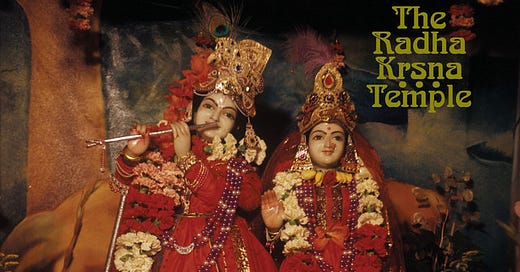Genre of the Day - Kirtan
Album of the Day - The Radha Krsna Temple by Radha Krsna Temple (1971)
Amidst a blitz of academic stress, it seems that the universe knew that I needed a palliative musical balm. Or perhaps, like many ‘spiritual but not religious’ practitioners, I’m drawing some cosmic conclusions where there aren’t any. A vague spiritualism is perhaps the easiest mechanism of projection of personal circumstances. I am certainly not immune to it. Today’s genre offers a chance to examine the religious practices that have been popularly distilled and proliferated through colloquialisms in the context of their deep reverence as expressed through music.
Kirtan music refers to a style of call-and-response music utilized across the scope of traditional Indian religious practices. Though the ancient Sanskrit songs of the practice are both most often associated with Hinduism, an attribute of the religion since its inception four thousand years ago, kirtan songs are broad and holistic—they also characterize the religious music of the country’s Sikh, Buddhist, and Bene Israel Jewish communities. The name kirtan (कीर्तन) simply translates as retelling—it is music meant to transmit stories across time. These are devotional songs, deeply indebted to the religious figures for which they are sung, sung in the bhakti devotional style in the case of Hinduism.
In the spirit of retelling, kirtan is often a communal practice, meant to be easily communicated between musicians and respondents in a practitioner space. This method of transmission has trickled down into western popular culture amidst increasing interactions between Indian spiritual practices and the western public consciousness—George Harrison’s “My Sweet Lord,” for instance, draws not only from “He’s So Fine” by the Chiffons but also the kirtan form of Hare Krishna, a mantra that had rose to popularity in Bhakti practices in the 15th century. Aligning with the variety of devotional themes kirtan can convey, players utilize a broad range of instrumentation: the lingering, hand-pumped harmonium often leads the melody, and string instruments like the veena and sitar and percussive elements like tablas, mrdangas, and talas round out the musical complementation to the storytelling.
Two George Harrison references does not an unofficial Beatles post make, but it may be the closest we get in this column. The most India-obsessed Beatle produced today’s album by devotees of the UK’s Hare Krishna branch. “Govinda,” an ode to Vishnu, opens the album as it opened the Sanskrit-speaking world to poetry thousands of years ago, cinematic strings and guitar capitulating to the temporal voices’ eternal glory. Musical moments of beauty shine across the album and underscore the deep beauty imbued in these worlds, as in the gorgeous crystalline chimes and tabla introducing the suite of “Bhaja Bhakata / Arati” and the gleeful harmonium of “Hare Krshna.” The solitary singer of “Bhaja Hunre Mana” draws you inescapably close to the recording, prompting contemplation whether you were considering doing so prior to this listen or not. It’s a stunning work that pays homage to an ancient tradition with as much dedication coming across in its gorgeous instrumental and vocal clarity as the devotion that created these tunes over the course of thousands of years.





